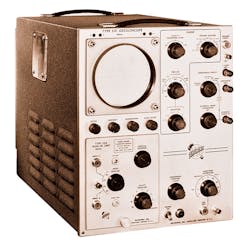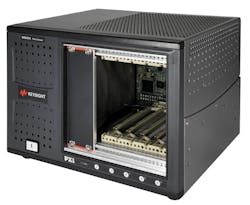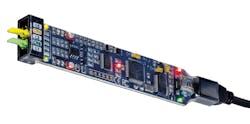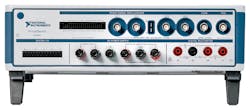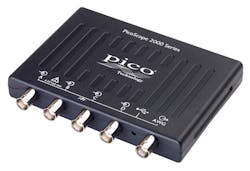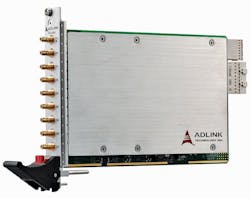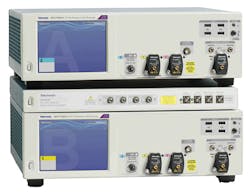There’s More Than One Way to Skin an Oscilloscope
This file type includes high resolution graphics and schematics when applicable.
Oscilloscopes are one of the primary electronic diagnostic tools, and there are a lot of vendors to choose from. While all oscilloscopes generally looked similar when they first appeared, things have changed radically since then. For example, do you know the difference between a digital phosphor oscilloscope (DPO) and a digital storage oscilloscope (DSO)?
With that in mind, here’s a little quiz: Out of all the devices depicted in Fig. 1, can you select the oscilloscopes?
The Tektronix 531 (Fig. 1a) was not the first oscilloscope, but it was one of the most memorable. It was developed in the 1950s and sold for more than 20 years. It cost a little more than $1,000 and had a 10-MHz bandwidth. At the other end of the spectrum is the stackable Tektronix DPO70000SX (Fig. 1h).
The DPO70000SX is a 70-GHz oscilloscope with a 200-Gsample/s sample rate. The Asynchronous Time Interleaving (ATI) architecture is designed to minimize noise while maintaining the highest fidelity for real-time signal acquisition. Multiple units can be synchronized and managed together, and it has a separate USB-based control panel with dials and buttons. The unit does have a small display screen, but it’s also designed to work with an external monitor.
Of course, not all oscilloscopes are as large or expensive, and many have features and probes designed for specific applications, such as power-integrity analyzers. Most still incorporate integrated displays, and some are even portable. Take Rohde & Schwarz’s Scope Rider (Fig. 1c), for instance, which has a four-hour runtime. It is first and foremost a lab oscilloscope with a 10-bit ADC, but also acts as a logic analyzer, protocol analyzer, data logger, digital multimeter, spectrum analyzer, harmonics analyzer, and frequency counter. It does have a 7-in., 800- by 480-pixel capacitive touch display, plus connectivity support that includes USB, Ethernet, and Wi-Fi.
Headless Test Equipment
Embedded designers can pack a processor and oscilloscope support hardware into a compact package like the Scope Rider, but sometimes an integrated solution is not a requirement. There are advantages to using a separate PC, including a wider selection of hosts.
BitScope’s USB-based oscilloscope (Fig. 1d) is an example of a class of compact test-and-measurement devices that significantly reduces the cost and size of the acquisition system. Some of these systems target students and the maker space with low-cost alternatives. While these may be less expensive, they can still pack a punch.
For example, the dual-channel BitScope Micro has a 20-MHz bandwidth with a 12-bit ADC. It also features a pair of analog comparator channels and a six-port logic analyzer. In addition, there’s a built-in analog waveform and digital clock generator. It can handle a range of protocols, including serial, SPI, I2C, and CAN.
Not bad for a 14 g package that’s also water-resistant. The PC software provides the user interface, and there’s an API, too. The BitScope hardware will also work with non-PC platforms like the Raspberry Pi—the latest version of which can handle four BitScopes thanks to four built-in USB ports. It is also a handy remote diagnostic platform that can be accessed via its network interface.
Moving to a bigger box allows additional features and more hardware to be included in a system. Pico Technology’s PicoScopes are USB-based test-and-measurement systems. The low-end PicoScope 2000 series (Fig. 1f), which includes a large, 128-Msample memory and 100-MHz bandwidth, starts at just over $100. The high-end PicoScope 9000 has a 20-GHz bandwidth and goes for more than $10,000. Still, all things are relative, as fully integrated oscilloscopes with this functionality are also expensive.
Another advantage of these smaller systems is that they can be placed closer to a device under test (DUT). Probes and cables help, but there are limits and tradeoffs. Having such flexibility helps in many instances. On the other hand, the extra cabling and PC could take up more room on a lab bench.
The modular approach allows designers to choose the features they need. Still, it’s often more economical to deliver an all-in-one instrument like National Instruments’ (NI) VB-8054 (Fig 1e). The VB-8054 is a 350-MHz mixed-signal oscilloscope, protocol analyzer, arbitrary waveform generator, and digital multimeter, with a programmable dc power supply and its own digital I/O. It’s designed to work with Virtual Bench software (Fig. 2), as well as NI’s own LabVIEW programming environment. LabVIEW allows the VB-8054 to be incorporated into automated test and control systems.
Bus-based test-and-measurement systems have been used to provide modular solutions to test, measure, and control applications. These can be used as transient diagnostic tools like oscilloscopes through permanent installations such as production lines.
The two primary solutions in this space include PXI System Alliance’s PCI eXtensions for Instrumentation (PXI) based on PICMG’s CompactPCI and CompactPCI Express standards, and the VXIbus Consortium’s VME eXtensions for Instrumentation (VXI) based on VITA’s VME standards. These standards add timing support necessary for synchronization between boards.
These systems normally incorporate a system control module that’s essentially a single-board computer (SBC). The SBC can run a standard operating system like Linux or Windows along with applications written using test-and-measurement tools, such as NI’s LabVIEW. These systems could tie into another computer that may provide a graphical interface.
Many vendors provide chassis, control modules, and data-acquisition modules for a complete solution. It’s usually possible to mix-and-match modules as well.
Keysight Technologies’ M9005A is a 5-slot, 3U PXI Express chassis with a built-in system control module. Two slots are for PXIe cards and the other three are hybrid PXIe slots. A hybrid slot can handle parallel bus PXI/PCI and PCI Express PXIe cards. The system doesn’t include a PXIe timing slot.
Data-acquisition cards like ADLINK Technology’s PXIe3-9848 (Fig. 1g) is an eight-channel PXI Express capture board. Its 14-bit ADC has a 100-Msample/s sample rate and can handle a 100-MHz input bandwidth. The board has 512 MB of storage with scatter-gather DMA data-transfer support for high-speed data streaming. As you might guess, this board is more likely to be used for high-speed signal-conditioning applications like radar systems or power-supply testing applications.
Networking Scopes
It’s almost a trivial exercise to link a PC to Wi-Fi or Ethernet. These days, the same is true for many oscilloscopes, since they’re essentially specially built PCs. Network support has a number of advantages, depending on what services may be supported by the scope. This might include data-transfer options to remote-control operation. It all hinges on the support provided by the vendor.
Some systems support APIs or have links with development tools like MathWorks’ MATLAB or LabVIEW. This allows developers to create custom test and control applications that can tie the oscilloscope to other networked equipment and software.
Users will need to consider tradeoffs between networking a conventional oscilloscope and a custom system like one based on Keysight’s M9005A. Security and reliability issues should also be considered, along with functionality.
Oscilloscopes are still used to track analog signals, but these days they can do much more. They can communicate with other systems and they may even wind up controlled by apps running on smartphones and tablets. The Tektronix 531 is unlikely to be on the list of supported scopes, but quite a few newer oscilloscopes may find their way onto it.
This file type includes high resolution graphics and schematics when applicable.
About the Author
William G. Wong
Senior Content Director - Electronic Design and Microwaves & RF
I am Editor of Electronic Design focusing on embedded, software, and systems. As Senior Content Director, I also manage Microwaves & RF and I work with a great team of editors to provide engineers, programmers, developers and technical managers with interesting and useful articles and videos on a regular basis. Check out our free newsletters to see the latest content.
You can send press releases for new products for possible coverage on the website. I am also interested in receiving contributed articles for publishing on our website. Use our template and send to me along with a signed release form.
Check out my blog, AltEmbedded on Electronic Design, as well as his latest articles on this site that are listed below.
You can visit my social media via these links:
- AltEmbedded on Electronic Design
- Bill Wong on Facebook
- @AltEmbedded on Twitter
- Bill Wong on LinkedIn
I earned a Bachelor of Electrical Engineering at the Georgia Institute of Technology and a Masters in Computer Science from Rutgers University. I still do a bit of programming using everything from C and C++ to Rust and Ada/SPARK. I do a bit of PHP programming for Drupal websites. I have posted a few Drupal modules.
I still get a hand on software and electronic hardware. Some of this can be found on our Kit Close-Up video series. You can also see me on many of our TechXchange Talk videos. I am interested in a range of projects from robotics to artificial intelligence.


